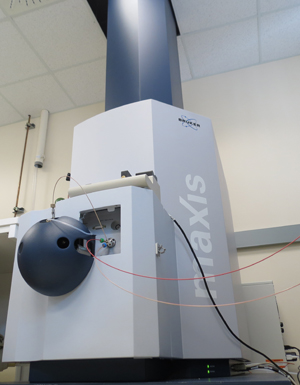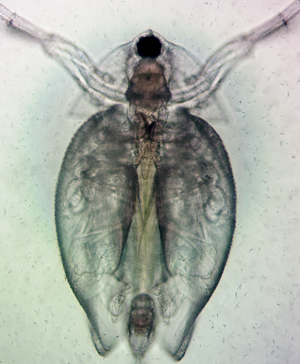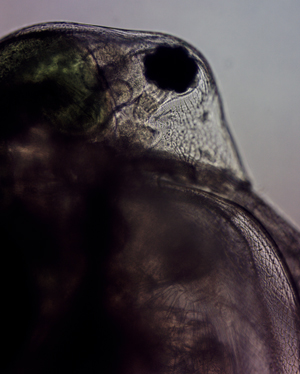Research
The problem of environmental contamination is becoming more complex: 30 years ago, the CAS registry numbered 107 compounds, currently we have exceeded 108and if the trend continues, there will be approximately 109 by 2040. If the number of compounds in the CAS registry can be used as a means to assess the extent of the diversity of environmental contamination, one can realize that we face significant challenges. We should add to this growing number of compounds their potential transformation products (degradation, metabolites), an emerging consideration for the evaluation of environmental risks. The occurrence of fragments of synthetic poymers in the environment of sizes between 5 milimeter and 1 micrometer, known collectively as microplastics, is another emerging issue that adds to the total burden of organic contaminants in the environment.
For that reason, the subject of my research is the study of contaminants at trace levels (concentrations < 1 ppb)in the environment. Because of the physicochemical properties (octanol-water partition constant, Henry's constant, etc.) of these trace organic contaminants (TrOCs) a considerable portion of these compounds will be found in aquatic and terrestrial environments. We have demonstrated that surface water contamination by TrOCs such as antibiotics is a global phenomenon and that economic factors, such as inadequate or absent sewage collection infrastructure, may aggravate this problem (Segura et al., 2015). However, to date, the impact of exposure to TrOC mixtures in biota is not yet well understood.
The Environmental and Analytical Chemistry Laboratory of Université de Sherbrooke aims to study the occurrence, environmental transformation and toxicity TrOCs. More specifically, my group is interested in developing and applying new techniques to assist in the process of identifying TrOCs and their transformation products in environmental waters. Also, I am interested in the research of new biomarkers to measure the subtle (sublethal) effects of TrOCs in a species frequently used in ecotoxicology, the water flea Daphnia magna.
The study of TrOCs in the environment presents new challenges because of their low concentration, their diversity, their unknown environmental fate and the lack of ecotoxicological data. Therefore, my research program consists of three main axes that aim to answer the following questions:
Axis # 1. Occurrence: What other TrOCs are present in environmental waters and at what concentrations?
Axis # 2. Environmental fate: What are the transformations products of TrOCs in the aquatic environment and how can we improve their identification?
Axis # 3. Toxicity: What are the most sensitive biomarkers of exposure of D. magna to TrOCs?
Occurrence
The presence of a large number of contaminants in the environment has not been detected for years due to inadequate extraction and detection methodologies. Consequently, our research efforts in this area have focused on the identification of TrOCs by non-target methods. These methods use the accurate mass and tandem mass spectra obtained by high resolution mass spectrometry to identify the presence of TrOCs in the environment.
For that reason, my group is interested in the improvement of non-target methods. However, the widespread application of such methods is limited by the level of confidence of the reported data. In many publications, structures are assigned to accurate masses with little experimental support (in some cases based only on the accurate mass). The road from accurate mass to molecular structure is long and winding, especially when working at trace concentrations in complex matrices. Therefore, it is imperative to develop new approaches to acquire structural information from the compounds observed to correctly identify new TrOCs and their transformation products.
Since 2013, my research group has focused on improving the identification of TrOCs in the environment. The correct and rapid identification of small trace organic molecules in the environment is a complex task that does not yet have an effective solution. For example, for an hypothetical ion of m/z 300.1234 of possible composition C0-100H0-100N0-10O0-10F0-5P0-5S0-5Cl0-5Br0-5I0-5Na0-1, 266 different formulas exist within 5 mDa of mass accuracy and between 0 and 20 insaturations. Additionally, each of these formulas can have multiple isomers, therefore the number of possible structures for a given accurate mass could be quite high.
 In order to carry out a contaminant identification with a good level of certainty using non-target methods, it is essential to use techniques that can provide complementary information on the composition and structure of the compound interest. Based on the confidence level system proposed by Schymanski et al. in 2014, we have developed a toolbox of techniques to resolve constraints that limit the assignment of higher confidence levels to detected compounds. We have systematically studied and applied novel approaches to the identification of TrOCs in the environment: post-column hydrogen-deuterium exchange (Eysseric et al., 2016), spectral accuracy (Eysseric et al., 2017), differential mobility spectrometry (Psutka et al., 2018) and a combinatorial tandem mass spectrum identification technique (Eysseric et al., 2021). This toolbox of experiments can beperformed in surface waters at environmental concentrations. We also conducted a study that identified some limitations of the non-targeted analysis (Segura et al., 2019) such as the solid phase extraction preconcentration step and chromatographic separation.
In order to carry out a contaminant identification with a good level of certainty using non-target methods, it is essential to use techniques that can provide complementary information on the composition and structure of the compound interest. Based on the confidence level system proposed by Schymanski et al. in 2014, we have developed a toolbox of techniques to resolve constraints that limit the assignment of higher confidence levels to detected compounds. We have systematically studied and applied novel approaches to the identification of TrOCs in the environment: post-column hydrogen-deuterium exchange (Eysseric et al., 2016), spectral accuracy (Eysseric et al., 2017), differential mobility spectrometry (Psutka et al., 2018) and a combinatorial tandem mass spectrum identification technique (Eysseric et al., 2021). This toolbox of experiments can beperformed in surface waters at environmental concentrations. We also conducted a study that identified some limitations of the non-targeted analysis (Segura et al., 2019) such as the solid phase extraction preconcentration step and chromatographic separation.
We have demonstrated that it is possible to design mass spectrometry-based experiments that can provide complementary information on the formula and structure of unknown TrOCs. For example, we have shown that it is possible to measure the spectral accuracy of the isotopic pattern (i.e. closeness to the theoretical pattern for a given formula) of organic contaminants at environmental concentrations in surface waters and to use this information to assign, in some cases an unambiguous formula (Eysseric et al., 2017). This approach eliminates many possible molecular formulas for a given accurate mass. Then, using the post-column hydrogen-deuterium exchange technique that we have developed, we can identify the number of labile hydrogen atoms in a given molecule without modifying the liquid chromatography method used (Eysseric et al., 2016). Determining the number of exchangeable hydrogens in a molecule allows us to eliminate possible functional isomers. A collaboration with Scott Hopkins (U. of Waterloo) showed that differential mobility spectrometry can be used to separate positional isomers of transformation product of a TrOC (Psutka et al. 2018). Finally, we have proved that a computational technique based on a combinatorial fragmentation algorithm of precursor ions is capable of rapidly screening TrOCs at environmental concentrations in surface water samples (Eysseric et al., 2021). This latter contribution will have a major impact in the field, since the biggest limitation of currently non-target methods is the limited number of compounds in empirical tandem mass spectrometry databases (less than 20000 compounds). The technique we propose does not use an empirical database, it uses the PubChem database (more than 960,000 compounds) to generate theoretical tandem mass spectra.
All these contributions will reduce the time needed to identify an unknown from a few months to a few days. This will have a major impact in my field and other areas interested in identifying small organic molecules of ecotoxicological interest at low concentrations.
Our interests in the microplatics focuses in their occurrence in river sediments. More precisely, we want to understand how microplastics interac with other TrOCs and their properties (polymer type, size, shape, etc.)
Fate
TrOCs are substances that can be transformed in the environment or in treatment plants by abiotic and biotic factors. The transformation products of TrOCs may retain or even increase biological activity as compared to parent compounds. Thus, it is imperative to understand their environmental fate, i.e. how they will behave when released into streams or agricultural soils. Our research in this area has focused on the identification of transformation products of TrOCs.
 The study of transformation products of small organic molecules by LC-HRMS is a complex task. The presence of laboratory contaminants and other interferences causes a multitude of peaks to be detected in the samples, making the identification process very time-consuming. To remedy this problem, we have developed a new and innovative method for identifying transformation products using the XCMS online platform. Then we applied it to the study of the reaction products of the ozonolysis of levofloxacin, an antibiotic frequently detected in the environment (Segura, et al. 2015). This work demonstrated that is possible to rapidly screen transformation products generated in controlled laboratory experiments. This method has already been applied in a study in collaboration with Environment and Climate Change Canada to the identification of transformation products of diclofenac and sulfamethoxazole (Poirier-Larabie et al., 2016).
The study of transformation products of small organic molecules by LC-HRMS is a complex task. The presence of laboratory contaminants and other interferences causes a multitude of peaks to be detected in the samples, making the identification process very time-consuming. To remedy this problem, we have developed a new and innovative method for identifying transformation products using the XCMS online platform. Then we applied it to the study of the reaction products of the ozonolysis of levofloxacin, an antibiotic frequently detected in the environment (Segura, et al. 2015). This work demonstrated that is possible to rapidly screen transformation products generated in controlled laboratory experiments. This method has already been applied in a study in collaboration with Environment and Climate Change Canada to the identification of transformation products of diclofenac and sulfamethoxazole (Poirier-Larabie et al., 2016).
We also explored the application of electrochemical methods (electrolysis, Fenton reaction, etc.) to mimic in the laboratory the abiotic and biotic transformation of trimethoprim, an antibiotic frequently detected in the environment, (Lecours et al., 2018). Our results demonstrated that trimethoprim oxidation products, generated by the various electrochemical methods, were the same as the metabolites (mammalian and bacterial) and the degradation products of the advanced oxidation processes used in the wastewater treatment plants reported in the literature. The transformation of small organic molecules by electrochemical methods has been little studied in the environmental sciences and can help us understand better the abiotic and biotic transformation of TrOCs in the environment. Coupling electrochemistry to HRMS to study transformation products is an interesting technique in situations where the matrix used is complex and the risks of interference with the detection method are high (e.g. biological culture media). Therefore our work in this research axis has developed interesting tools to improve our understanding the fate of TrOCs in the aquatic environment.
We are also interested in the fate of microplastics in sediments, specially the formation of new functional groups at their surface that may affect their interaction with other TrOCs as well as their transport and toxicity.
Toxicity
 One of the biggest difficulties in studying the effects of TrOCs on biota is that at environmental concentrations, their adverse effects are not easily measurable, but can be accumulative and even irreversible in the long term. Ternes and Daughton have called this phenomenon "subtle effects". These changes may go unnoticed because they manifest in a detectable and irreversible way only after several generations. It is then important to develop new, more sensitive bioassays that allow us to identify subtle effects in a short period of time. The approach we propose is based on metabolomics, the science of identifying and quantifying all the metabolites of a species. Our hypothesis is that it is possible to identify key metabolites for the survival of a species that can be used as biomarkers of the harmful effects of TrOCs in a short period of time and at low concentrations.
One of the biggest difficulties in studying the effects of TrOCs on biota is that at environmental concentrations, their adverse effects are not easily measurable, but can be accumulative and even irreversible in the long term. Ternes and Daughton have called this phenomenon "subtle effects". These changes may go unnoticed because they manifest in a detectable and irreversible way only after several generations. It is then important to develop new, more sensitive bioassays that allow us to identify subtle effects in a short period of time. The approach we propose is based on metabolomics, the science of identifying and quantifying all the metabolites of a species. Our hypothesis is that it is possible to identify key metabolites for the survival of a species that can be used as biomarkers of the harmful effects of TrOCs in a short period of time and at low concentrations.
 To test this hypothesis, we focused our research efforts on quantifying metabolites essential for the survival of a model species, the water flea Daphnia magna. This species, which is widely used in ecotoxicology, occupies an important place in lacustrine ecosystems (primary consumer, fish food source) and is also easy to cultivate in the laboratory. We identified ecdysteroids and retinoic acids as potential biomarkers of the harmful effects of contaminants given their essential role for D. magna survival and reproduction. Therefore, we proceeded to the development of a sensitive method of quantification of three ecdysteroids (ecdysone, 20-hydroxyecdysone and ponasterone A) and two retinoic acids (9-cis retinoic acid and all-trans retinoic acid) in daphnids (Venne et al., 2016). Our results demonstrated that 20-hydroxyecdysone was quantifiable (19 ± 8 pg per individual) in adult daphnids, but the other analytes were below the limit of detection using less than 25 daphnids. We continued this work by exposing daphnids to different mixtures of commonly detected TrOCs in the environment such as pharmaceuticals and pesticides. We have demonstrated that 20-hydroecdysone concentration changes were quantifiable in these assays and the concentrations of this ecdysteroid were significantly different in the exposed versus control groups when the daphnids were exposed to 1000 ng L-1 of the TrOCs. These results suggest that 20-hydroecdysone could be a very sensitive biomarker of exposure to certain TrOCs, especially those capable of altering lipid metabolism.
To test this hypothesis, we focused our research efforts on quantifying metabolites essential for the survival of a model species, the water flea Daphnia magna. This species, which is widely used in ecotoxicology, occupies an important place in lacustrine ecosystems (primary consumer, fish food source) and is also easy to cultivate in the laboratory. We identified ecdysteroids and retinoic acids as potential biomarkers of the harmful effects of contaminants given their essential role for D. magna survival and reproduction. Therefore, we proceeded to the development of a sensitive method of quantification of three ecdysteroids (ecdysone, 20-hydroxyecdysone and ponasterone A) and two retinoic acids (9-cis retinoic acid and all-trans retinoic acid) in daphnids (Venne et al., 2016). Our results demonstrated that 20-hydroxyecdysone was quantifiable (19 ± 8 pg per individual) in adult daphnids, but the other analytes were below the limit of detection using less than 25 daphnids. We continued this work by exposing daphnids to different mixtures of commonly detected TrOCs in the environment such as pharmaceuticals and pesticides. We have demonstrated that 20-hydroecdysone concentration changes were quantifiable in these assays and the concentrations of this ecdysteroid were significantly different in the exposed versus control groups when the daphnids were exposed to 1000 ng L-1 of the TrOCs. These results suggest that 20-hydroecdysone could be a very sensitive biomarker of exposure to certain TrOCs, especially those capable of altering lipid metabolism.
These contributions demonstrate that monitoring metabolites is an interesting approach to better understand the effects of TrOCs in aquatic species. Also, our studies have revealed that the toxicity of the mixtures of the TrOCs must be studied systematically since results having contrary effects (suppression, increase) on the concentrations of 20-hydroecdysone were observed. Therefore, environmental metabolomics techniques developed by my laboratory will allow us to study a new dimension of information on the impact, at the molecular level, of environmental contamination on the survival of this aquatic species.
Other projects
Fate of pharmaceuticals in hospital effluents after treatment by wet-air oxidation (in collaboration with CTTÉI
Fate of pesticides in honey bees